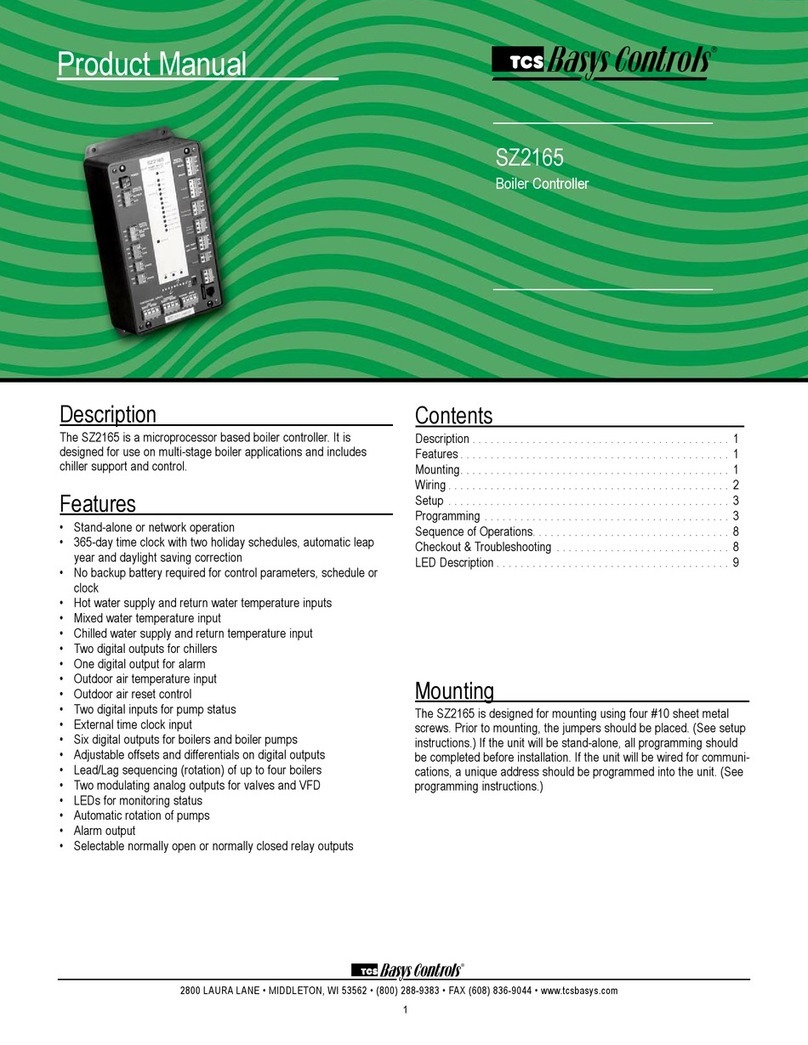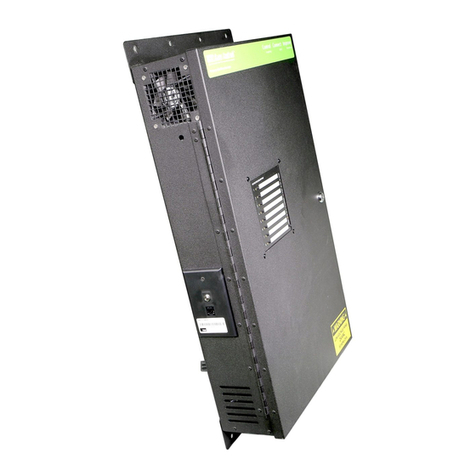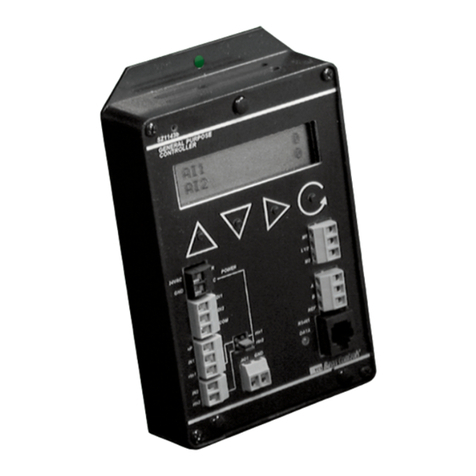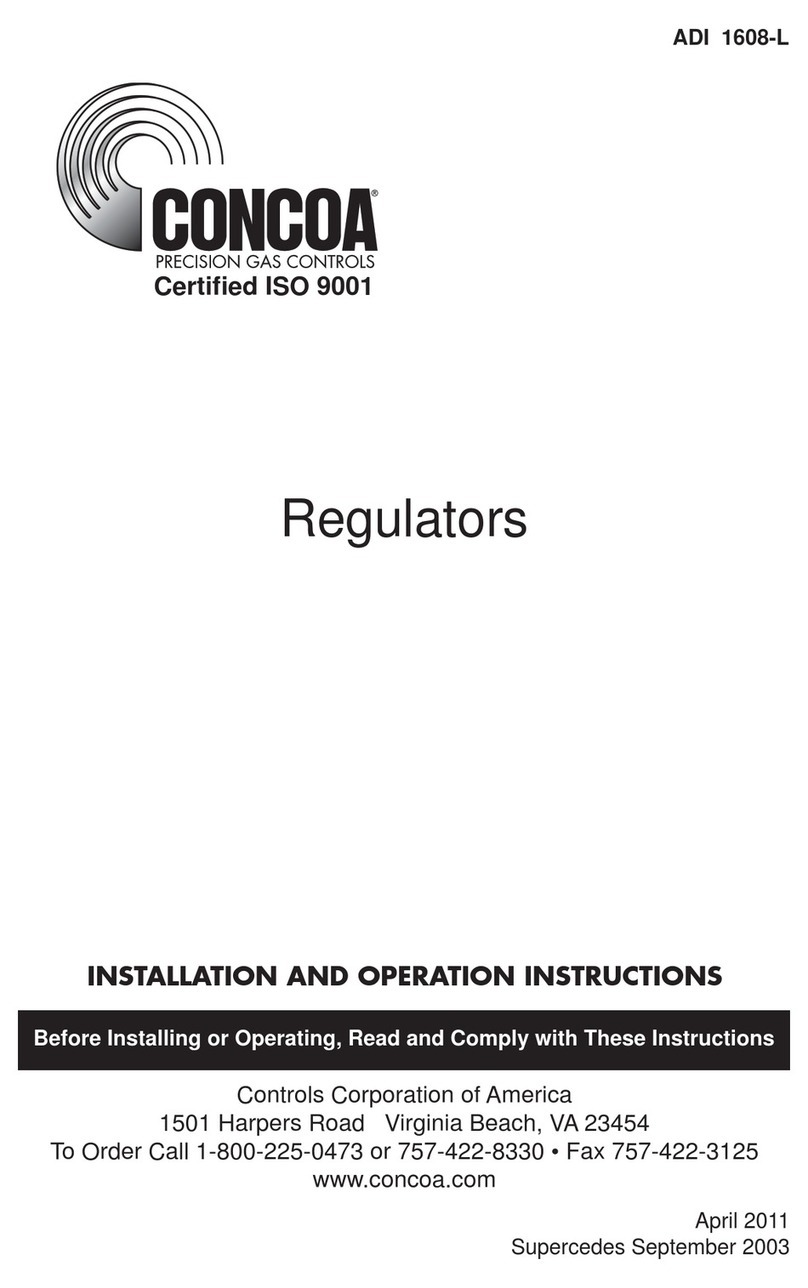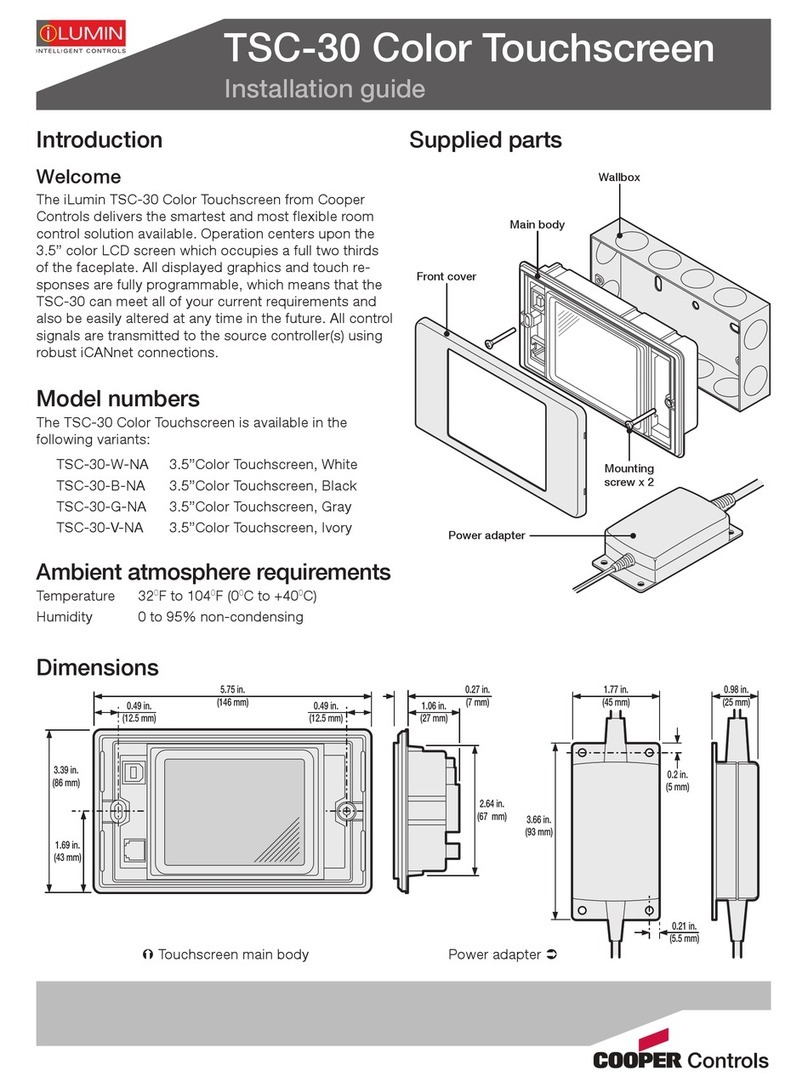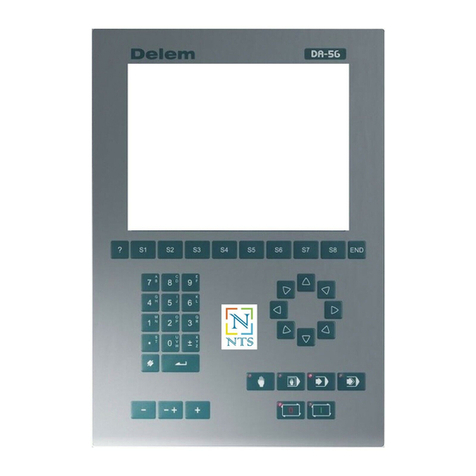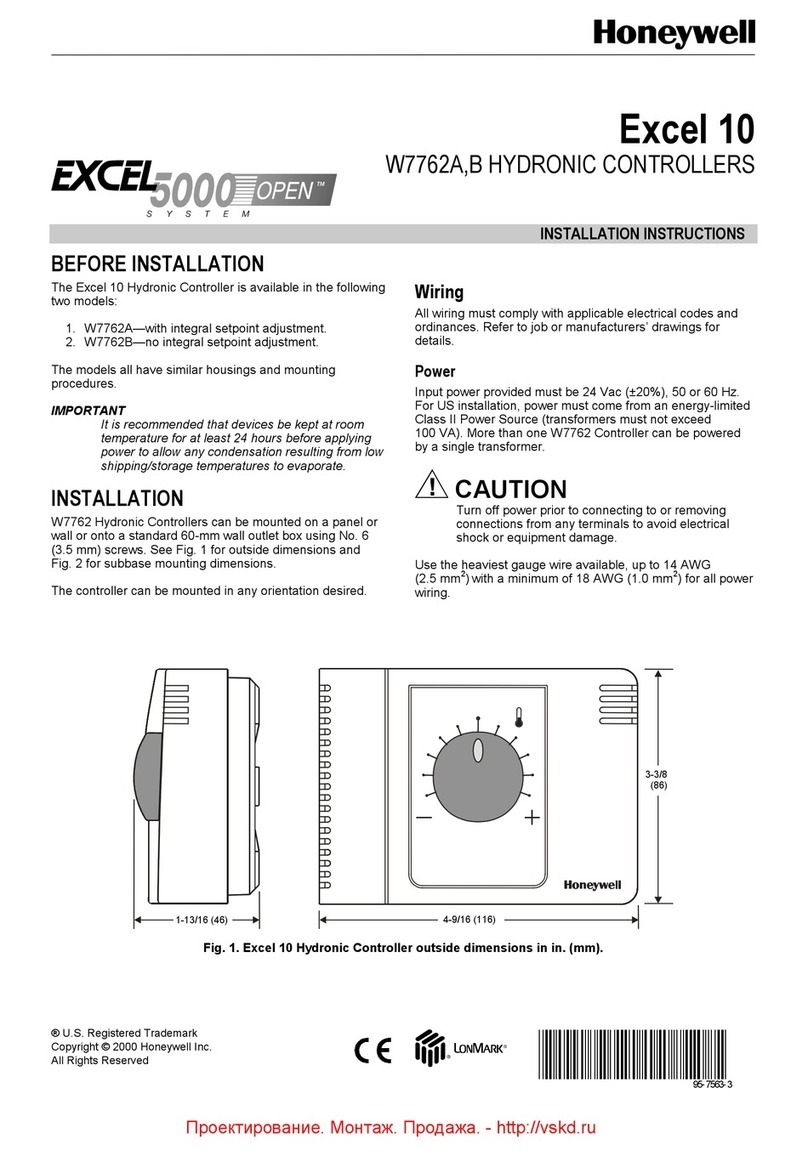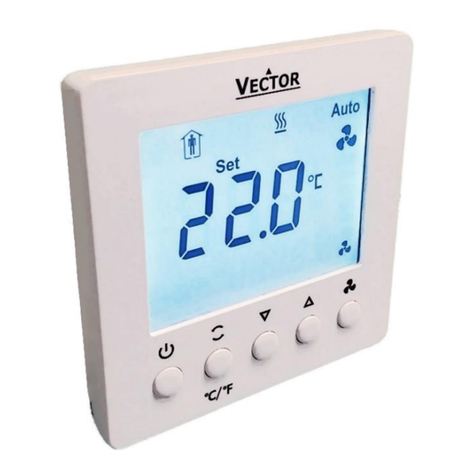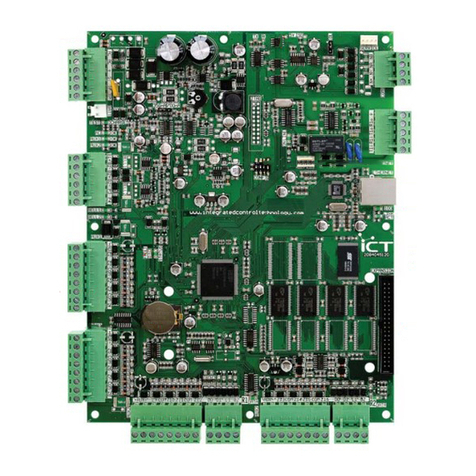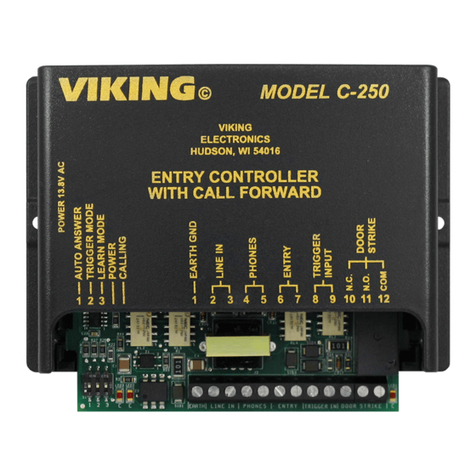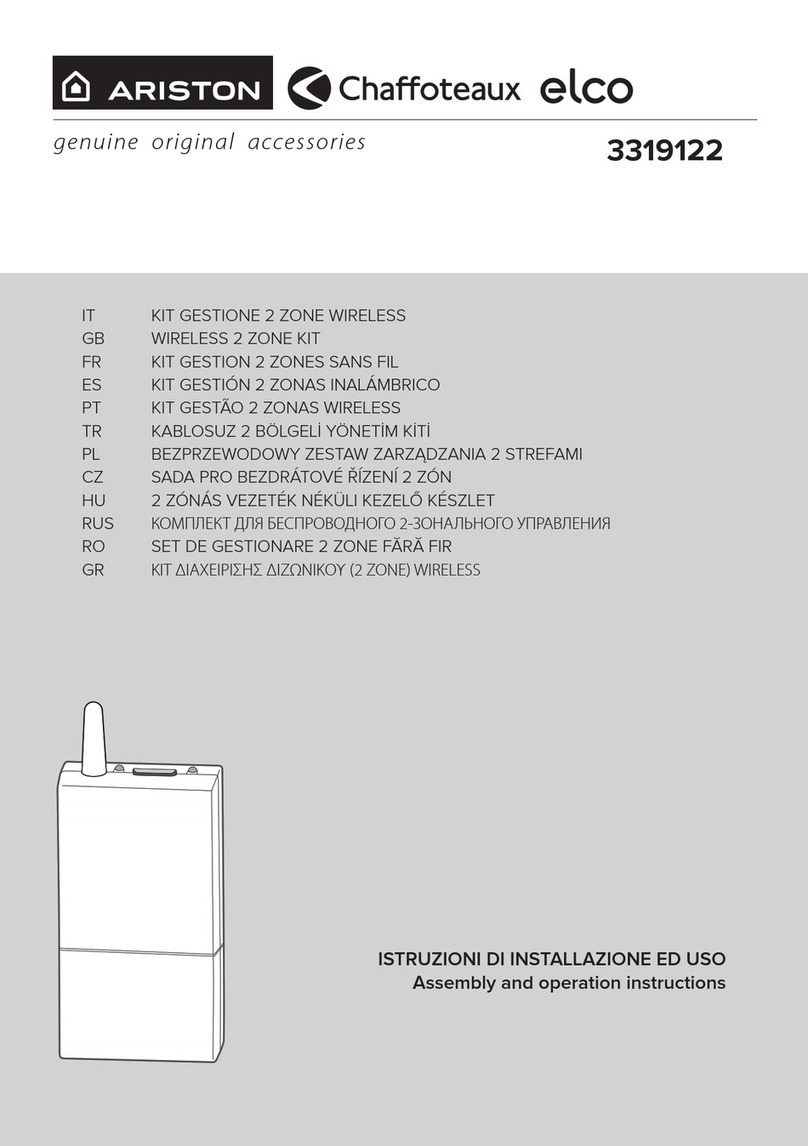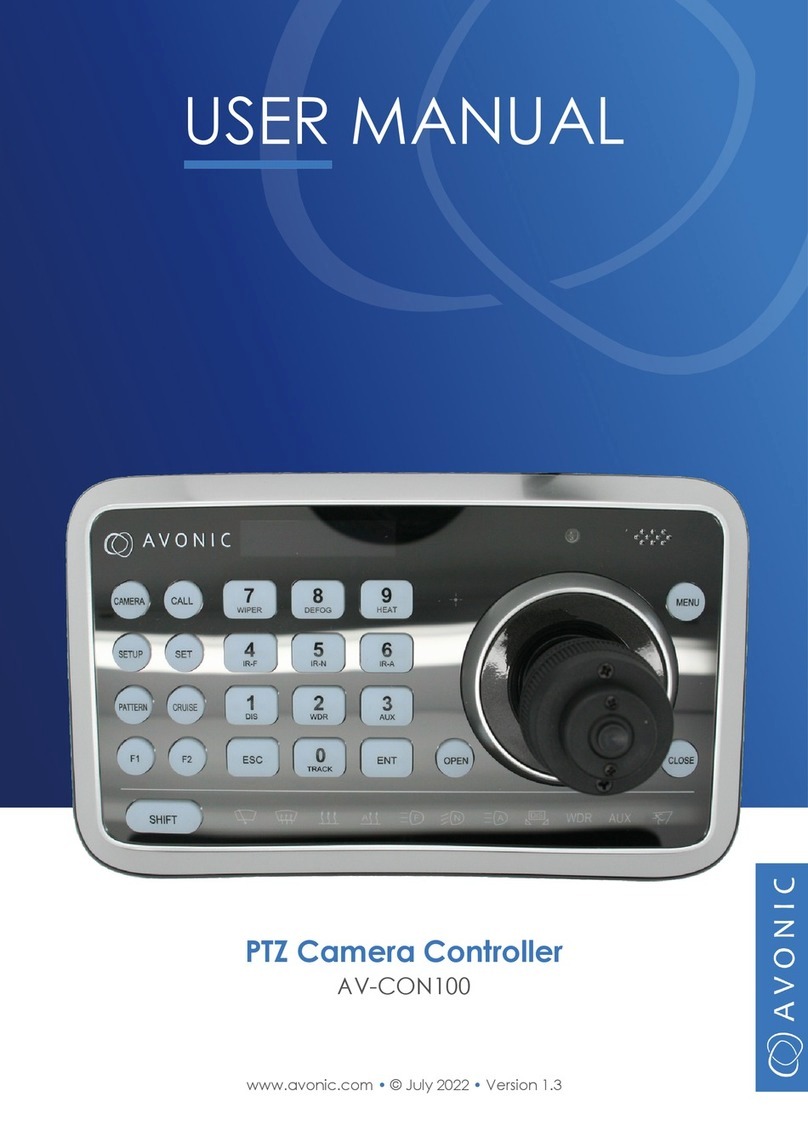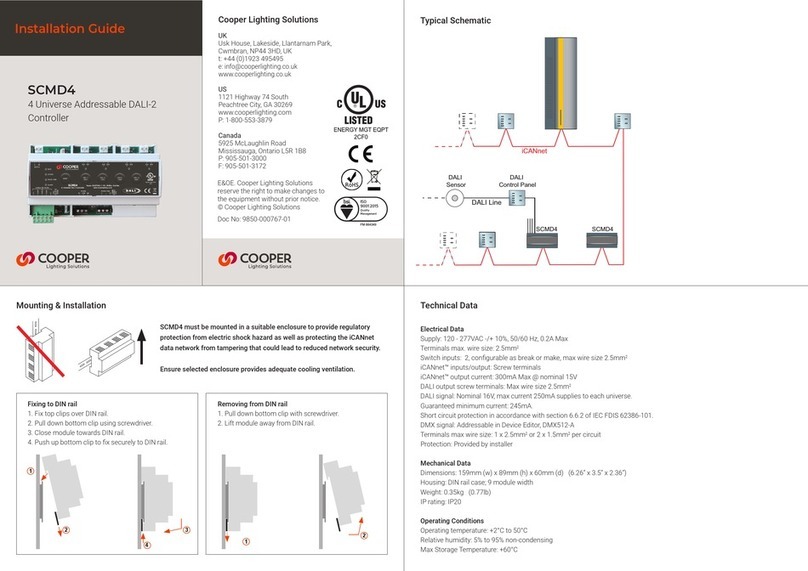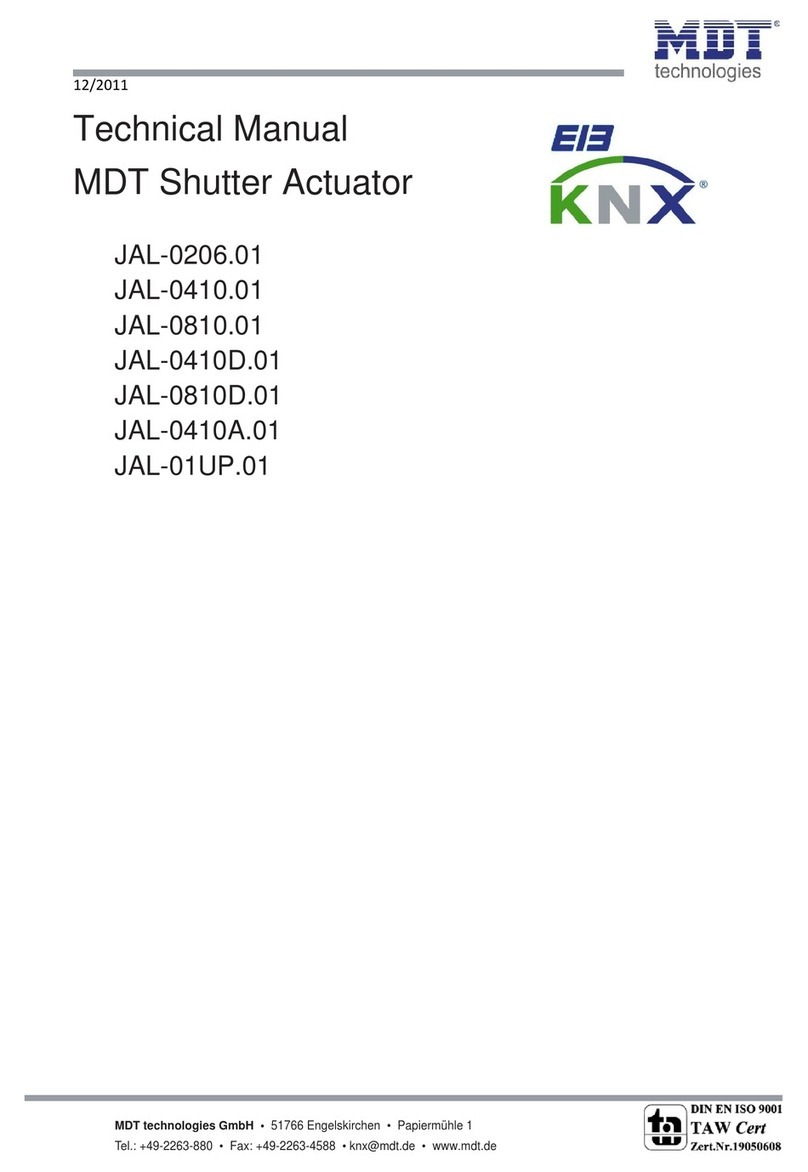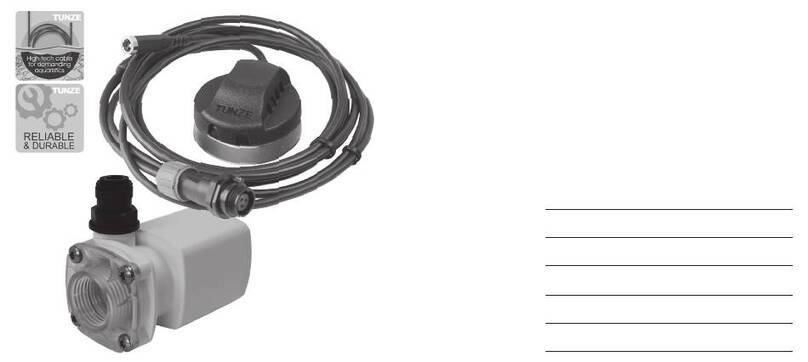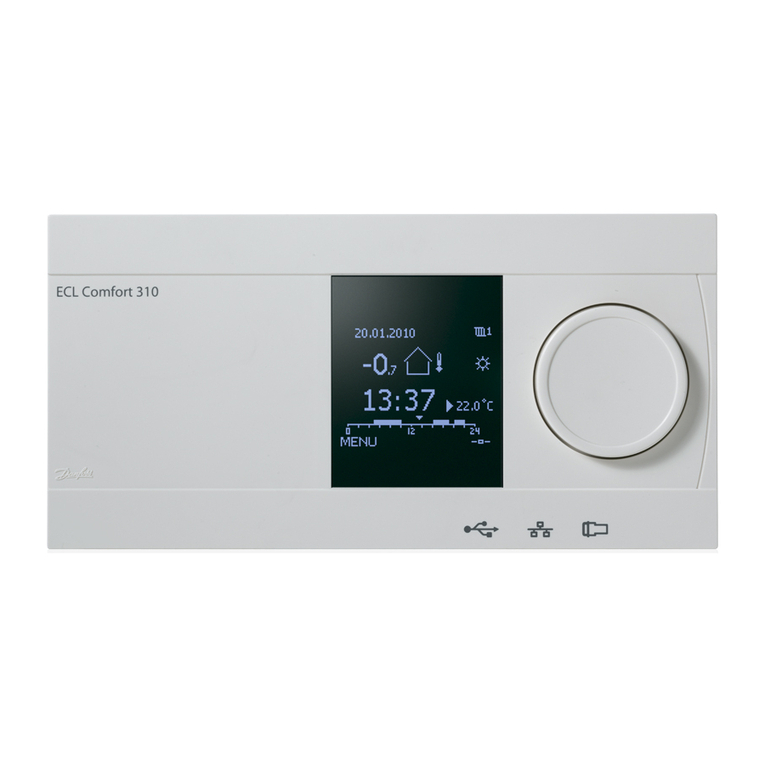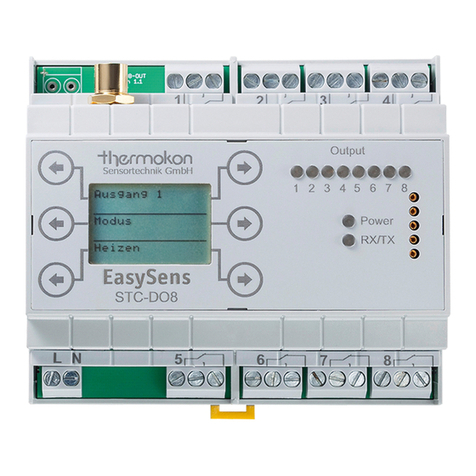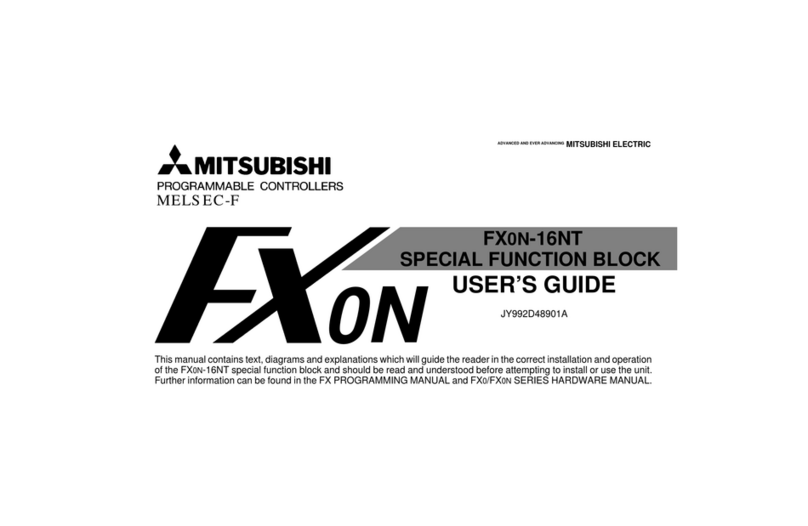TCS Basys Controls SZ1025b User manual

R
2800 LAURA LANE • MIDDLETON, WI 53562 • (800) 288-9383 • FAX (608) 836-9044 • www.tcsbasys.com
1
SZ1025b
VAV Box Controller
Product Manual
Description
The SZ1025b is a microprocessor-based controller
designed for VAV terminal unit applications.
Features
• Stand-alone or network operation
• Built-in velocity pressure sensor with K-factor
correction
• Pressure dependent or pressure independent
operation
• Capable of controlling series or parallel fan-powered
boxes
• Offers two independent modulating outputs
• Adjustable PID control of modulating outputs
• Interface available for tri-state actuator motors (QE25)
• Separate heating and cooling minimum and maximum
CFM settings
• Four independent dry contact outputs
• Remote setpoint capability
• Discharge air sensor input
• Filter monitor input
• External time clock input
Contents
Description . . . . . . . . . . . . . . . . . . . . . . . . . . . . . . . . . .1
Features . . . . . . . . . . . . . . . . . . . . . . . . . . . . . . . . . . . .1
Mounting. . . . . . . . . . . . . . . . . . . . . . . . . . . . . . . . . . . .1
Wiring . . . . . . . . . . . . . . . . . . . . . . . . . . . . . . . . . . . . . .2
Setup . . . . . . . . . . . . . . . . . . . . . . . . . . . . . . . . . . . . . .3
Programming . . . . . . . . . . . . . . . . . . . . . . . . . . . . . . . .3
Sequence of Operations. . . . . . . . . . . . . . . . . . . . . . . .5
Checkout & Troubleshooting . . . . . . . . . . . . . . . . . . . .8
LED Description . . . . . . . . . . . . . . . . . . . . . . . . . . . . . .8
Mounting
Use two #10 sheet metal screws to mount the SZ1025b.
For best results, the room sensor should be mounted on
an interior wall that reflects normal room environment, at
a height of approximately five feet from the floor. Avoid
areas exposed to direct sunlight, unusual heat sources,
open doors and windows, or unventilated locations.

R
2800 LAURA LANE • MIDDLETON, WI 53562 • (800) 288-9383 • FAX (608) 836-9044 • www.tcsbasys.com
2
Wiring
The SZ1025b terminal designations are shown below.
REMOTE SENSOR WIRING
The SZ1025b accepts two 1000 Ωtwo-wire platinum
RTD sensors. Use TS2000 or TS3000 for room sens-
ing, TS2023a for room sensing with setpoint adjustment
and TS1009 or TS1002 for duct sensing. When using
TCS Basys Controls three-wire sensors, use the black
and red leads, and either clip or twist off the white lead.
The wiring length from the room sensor to the SZ1025b
should not exceed 250 ft.
POWERING THE SZ1025b
The SZ1025b is powered from 24 VAC +/- 10 %. If wir-
ing for communications, dedicated power must be used
to power the SZ1025b. Several S-series thermostats
may be powered from the same transformer, provided
that the transformer has enough power.
Caution: When multiple TCS Basys Controls
devices are using a single transformer, the
polarity of the power wiring must be maintained
because all TCS devices are half-wave
rectified.
CW
COM
CCW
CW
COM
CCW
QE25 TRI_STATE INTERFACE
24 VAC
GND
Twisted, Shielded 18 AWG. Must be run separately.
24VAC tansformer. The SZ1025b power must be dedicated.
If using TS2000 or TS1009, use red and black leads.
4 to 20mAoutput. 600 Ohm max. Do not power actuators with
SZ1025b power. THe SZ1025b is half-wave recrified, where by the
power ground is common with the signal ground.
1
2
3
4
Dry contact. Must not be powered.
Dry contact rated 24 VAC @ 2A. Do not power relay with SZ1025b
power.
If not using TS2023a setpoint adjustment pot., you must short SP
to GND.
5
6
7
Optional QE25 Tri-state interface wiring
In from SZ1025b
TS2023a wiring to
SZ1025b
A
B
+5VA
AII
AGND
T1
T1
T2
T2
ZONE
SUPPLY
0
1
2
3
6
5
4
1CDA
CVA
2
+
-
DI1
DI2
GND
+5VA
AI1
AGND
TEMP
TEMP
CW1
CCW1
CW2
CCW2
AO1
AO2
GND
ST1
COM
ST2
POWER FLOATING
POINT
CONTROL
ST3
COM
ST4
A
B
REF
ANALOG
TEMP
INPUTS
DIGITAL
TEMP
INPUTS
SHARED
TEMP
OUTPUTS
T1 T1 T2 T2 T3+ T3- T4+ T4- TEMP REF
ZONE SUPPLY ZONE SUPPLY
LOW PRESSURE
HIGH PRESSURE
SHARED
TEMP
REMOTE
SETPOINT
ANALOG
INPUTS
DIGITAL
INPUTS
DIGITAL
OUTPUTS
ANALOG
OUTPUTS
DATA
RS485
DAMPER
VALVE
QE25
SZ1025B
VAV CONTROLLER
2+
-
5
5
3
3
1
BAREF
DO1
DO2
DO3
DO4
4
+
-DA
4
+
-DA
6
R
6
R
OUT TO
QE25
6
R
6
R
2
+
-

R
2800 LAURA LANE • MIDDLETON, WI 53562 • (800) 288-9383 • FAX (608) 836-9044 • www.tcsbasys.com
3
Setup
PRESSURE CONNECTIONS
For pressure indepen-
dent applications, the
SZ1025b provides a
velocity pressure trans-
ducer. To utilize this,
connect the high port
on the SZ1025b to the
air flow measuring sta-
tion port or pitot tube
port that faces the flow.
Connect the low port on
the SZ1025b to the air
flow measuring station
port or pitot tube port
that faces away from
the flow.
USING TRI-STATE ACTUATORS
If using tri-state instead of 4 to 20 mA, actuators a QE25
transducer is available. To connect the QE25 to the
SZ1025b, use the ribbon connector included with the
QE25 as shown, in the wiring section.
Programming
The SZ1025b may be programmed through the display
and keypad, or with a PC.
If programming with a PC, the following must be set
through the keypad prior to programming:
• Address (step #2)
• Baud rate (step #3)
For more information on programming through the PC,
consult your TCS software manual.
Programming through the Keypad
To access the programming screens, press both the
“Scroll” and “Next” keys simultaneously.
Scroll Key - The "Scroll" key is also used
to save any changes to the "current" screen
and advance to the next screen while pro-
gramming. The "Scroll" key is used to enter
the Programming Mode when pressed with
the "Next" key.
Next Key - Used to enter Programming Mode
when pressed with the “Scroll” key. Also used
to move from the ones, to the tens, hundreds
decimal point and to exit programming with out
saving changes to the current screen.
Increment/Decrement Keys - Used to select
the desired value.
Zone temp
71F Main Monitoring Screen. Press the
scroll and next buttons to access the
following screens.
Access Code Entry Screen. Enter
the access code. If the wrong code is
entered, the prorm reverts to the main
screen. 248 is the default access cose.
Controller Address Screen. If using a
PC to access the SZ1025b, set a unique
address from 0 to 255, excluding 248.
Communication Baud Rate Screen. If
using a PC to access the SZ1025b, all
contollers on a network must be set to the
same baud rate. Choose between 2.4K,
4.8K, 9.6K and 19.2K.
Temperature Selection Screen.
Select whether youwant to show Deg.
Fahrenheit or Celsias.
Shared Temperature Enable Screen.
Sharing zone temperature with another
SZ1025b (2 max.) Select YES if not
select NO.
Zone Temperature Calibration Screen.
Enter a calibration factor (+/- 25°F) for
zone temperature Input. The temperature
displayed on the left is the actual tem-
perature.
Supply Temperature Calibration
Screen. Enter a calibration factor (+/-
50°F) for supply temp Input. The tem-
perature displayed on the left is the actual
temperature.
Pressure Calibration Screen. Enter a
calibration factor (+/- 0.50WCD) for
pressure. The value of the left is the
actual value.
Setpoint Low Limit Value Screen. Enter
a setpoint low limit value. The setpoint
will not be allowed to be set lower than
this setting.
+
ENTER ACCESS
CODE 000
1.
SET ADDRESS:
000
2.
SET BAUD RATE:
9.6k
3.
TEMPS SHOWN IN:
FAHRENHEIT
4.
ENABLE SHARED
TEMP INPUT? NO
5.
ZONE T. CAL
90F 0.0F
6.
SUP. T. CAL
150F 0.0F
7.
PRESS CAL
0.00WCD 0.000 W
8.
CW1
CCW1
CW2
CCW2
POWER FLOATING
POINT
CONTROL
ANALOG
TEMP
INPUTS
DIGITAL
TEMP
INPUTS
SHARED
TEMP
OUTPUTS
T1 T1 T2 T2 T3+ T3- T4+ T4- TEMP REF
ZONE ZONE
LOW PRES-
HIGH PRES-
SHARED
TEMP
REMOTE
SETPOINT
ANALOG
INPUTS
DIGITAL
INPUTS
DIGITAL
OUTPUTS
ANALOG
OUTPUTS
DATA
RS485
DAMPER
VALVE
QE25
SZ1025B
VAV CONTROLLER
LOW PRESSURE
HIGH PRESSURE
SETPOINT LOW
LIMIT: 40.0F
9.

R
2800 LAURA LANE • MIDDLETON, WI 53562 • (800) 288-9383 • FAX (608) 836-9044 • www.tcsbasys.com
4
J-FACTOR:
NORMAL
15. J-factor Screen. Select if Normal or
Inverted. J-factor will be used.
K-factor Screen. Enter a "K" factor, if
appliciable.
Duct Screen. Enter wheater the VAV
duct is Round or Rectangular.
Duct Size Round. Enter diameter in
inches.
Duct Size Rectangular. Enter the length
in inches.
DUCT
ROUND
17.
DUCT
DIAMETER: 9.0
18.
DUCT SIZE
LENGTH: 9.0
19.
DUCT SIZE
WIDTH: 6.0
20.
AO1
ACTION: DIRECT
21.
AO1
CHOICE: MODULATING
22.
AO1 MODE
IS: COOL
23.
HT/COOL
SETPOINT: 70
24.
IF RECTANGULAR
SELECTED GO TO
STEP 19.
AO1 CFM
PROP BAND: 10.0%
26.
AO1 OUTPUT
RANGE: 4-20mA
27.
DAMPER:
PRES INDEPENDENT:
28.
AO1 TEMP
PROPBAND: 10.0%
25.
K-FACTOR:
1.0
16.
Analog Output/Temperature
Proportional Band. Enter in the % or
input span (40 to 90) the number of
degrees away from setpoint + deadband
that the device will be fully open.
Analog Output/CFM Proportional
Band. Enter in the % or input span (0 to
1" WCD) the cfm proportional band.
Analog Output/Output Range. Choose
whether the output range will be 0-20mA
or 4-2omA
for Pressure Indepentant you must
program CFM min and max values via
software
Damper Screen. Enter whether the
damper control should be pressure
dependant or pressure independant.
If pressure indepentant is selected skip
to step 33
Setpoint High Limit Value Screen. Enter
a setpoint high limit value. The setpoint
will not be allowed to be set higher than
this setting.
Setpoint Source Screen. Select whether
you are using a LOCAL (setpoint from
TS2023a) or REMOTE (as programmed in
step#12 or via software) setpoint.
Setpoint Screen. Enter a setpoint value
for control. (This screen does not appear
if Local Setpoint is programmed in soft-
ware).
Occupied Deadband Screen. Enter an
occupied deadband. This is +/- the set-
point where no control is done, during the
occupied time period. This is a number
from 0 to 100% of input span.
Unoccupied Deadband Screen. Enter an
unoccupied deadband. This is +/- the set-
point where no control is done, during the
unoccupied time period. This is a number
from 0 to 100% of input span.
SETPOINT HIGH
LIMIT: 90.0F
10.
SETPOINT SOURCE:
LOCAL
11.
SETPOINT
REMOTE: 72
12.
OCCUPIED
DEADBAND: 2.0%
13.
UNOCCUPIED
DEADBAND: 10.0%
14.
Duct Size Rectangular. Enter the width
in inches.
Analog Output 1 Action Screen. Choose
whether the output will be
direct or reverse acting. (If output is
programmed for Ht/cbol mode the output
will automatically reverse action)
Analog Output 1 Choice Screen. Choose
whether the output will be
modulating (AO1) or floating (NO5/NO6).
Analog Output 1 Mode Screen. Choose
whether output will be used for COOL,
HEAT or HT/COOL.
Ht/Cool Supply Setpoint Change Over
Screen. Enter the supply air temperature
at which you wish to change from heat-
ing to cooling or vice versa (this screen
will not show if AO1 mode is not set for
HT/COOL).

R
2800 LAURA LANE • MIDDLETON, WI 53562 • (800) 288-9383 • FAX (608) 836-9044 • www.tcsbasys.com
5
COOL MINIMUM POSITION:
5.0%
29.
COOL MAXIMUM POSITION:
80.0%
30.
HEAT MINIMUM POSITION:
5.0%
31.
HEAT MAXIMUM POSITION:
80.0%
32.
AO1 MOTOR
TIME: 1.5 MIN
33.
AO2
ACTION: DIRECT
34.
AO2
CHOICE: MODULATING
35.
AO2 MODE
IS: HEAT
36.
AO2 SETPOINT
OFFSET 1.0F
37.
AO2 PROP
BAND: 10.0%
38.
AO2 OUTPUT
RANGE: 4-20mA
39.
AO2 MOTOR
TIME: 1.5 MIN
40.
STAGE 1
DIFF: 1.0F
43.
STAGE 2 MODE
AS: HEAT
44.
STAGE 2
OFFSET: 3.0F
45.
STAGE 2
DIFF: 1.0F
46.
Pressure Dependant Screen. Enter in %
the min cooling damper position.
Pressure Dependant Screen. Enter in %
the max cooling damper position.
Pressure Dependant Screen. Enter in %
the min heating damper position.
Pressure Dependant Screen. Enter in %
the max heating damper position.
Enter floating motor time in min.
Anolog Output 2 Action Screen.
Choose whether the output will be direct
or reverse acting.
Anolog Output 2 Choice Screen.
Choose whether the output will be modu-
lating (AO2) or floating (NO7/NO8).
Anolog Output 2 Mode Screen. Choose
whether the output will be used for heat-
ing or cooling.
Anolog Output 2 Setpoint Screen.
Enter the number of degrees you wish to
offset the output from setpoint.
Anolog Output 2 Proportional Band
Screen. Enter in % of input span (40 to
90) the number of degrees away from
setpoint + deadband the offset that the
device will be fully open.
Anolog Output 2 Output Range Screen.
Choose wether the output range will be
0-20mA or 4-20mA.
Enter floating motor time in min.
Stage 1 Mode Screen. Select wether the
relay control: HEAT, COOL, or FAN.
Stage 1 Offset Screen. Enter an offset
valve for Stage 1.
Stage 1 Differential Screen. Enter a dif-
ferential value for Stage 1.
Stage 2 Mode Screen. Select wether the
relay control: HEAT, COOL or TCLK.
Stage 2 Offset Screen. Enter an offset
valve for Stage 2.
Stage 2 Differential Screen. Enter a dif-
ferential value for Stage 2.
STAGE 1 MODE
AS: HEAT
41.
STAGE 1
OFFSET 2.0F
42.

R
2800 LAURA LANE • MIDDLETON, WI 53562 • (800) 288-9383 • FAX (608) 836-9044 • www.tcsbasys.com
6
REQUIRE CODE FOR
PROGRAMMING? NO
53.
SETACCESS
CODE: 248
54.
ZONE TEMP
71
Stage 3 Mode Screen. Select wether
the relay control: HEAT, COOL, FAN,
or OCC functions.
Stage 3 Offset Screen. Enter an off-
set valve for Stage 3.
Stage 3 Differential Screen. Enter a
differential value for Stage 3.
Stage 4 Mode Screen. Select wether
the relay control: HEAT, COOL, FAN,
or OCC functions.
Stage 4 Offset Screen. Enter an off-
set valve for Stage 4.)
MOTOR TIME
Enter the “Motor Time” in minutes if you choose that the
actuator is “floating or tri-state”. Larger times will slow
down the response and smaller times will speed up the
response. The number of minutes is from 1 to 10 min-
utes. We recommend to use the speed actuator takes to
go from fully open to fully closed.
STAGE 3 MODE
AS: HEAT
47.
STAGE 3
OFFSET: 4.0F
48.
STAGE 3
DIFF: 1.0F
49.
STAGE 4 MODE
AS: HEAT
50.
STAGE 4
OFFSET: 5.0F
51.
STAGE 4
DIFF: 1.0F
52. NO4 Differential Screen. Enter a dif-
ferential value for Stage 4.
Programming Access Screen.
Choose whether or not a code will be
required to enter programming setup.
Access Code Screen. Enter an
access (0 to 255) code that will be
used to enter the programming and/or
clock and schedule setups if access
code had been rrequired in the last
two steps. The default is 248.
Main Monitoring Screen.
AUXILIARY RELAYS STAGE 1&2
Select the mode for which can be “Heat” or “Cool” con-
trol, and for Stage 3&4 which can be “Heat” or “Cool”
control, "FAN" controls or for an external time clock “Occ”
signal.
For a “Cooling” output, the relay energizes when the
input equals the “Setpoint” + “Deadband” + “Offset” +
“Differential and de-energizes when the input falls to the
“Setpoint” + “Deadband” + “Offset.”
For a “Heating” output, the relay energizes when the
input equals the “Setpoint” - “Deadband” - “Offset” -
“Differential and de-energizes when the input rises to the
“Setpoint” -“Deadband” - “Offset.”
For “Fan” control, the relay is energized during the occu-
pied time and energized on a call for heat or cool during
the occupied time.

R
2800 LAURA LANE • MIDDLETON, WI 53562 • (800) 288-9383 • FAX (608) 836-9044 • www.tcsbasys.com
7
HEAT COOL HT/CL
AO1 PRESSURE DEPENDENT MODE
max%
Room Temp (F)
20
12
4P(temp)
SP+DB
=min% max%
cool
Room Temp (F)
20
12
4P(temp)
SP+DB
=min%cool
SP-DB
=min% heat
max%
heat
SP-DB
=max%
Room Temp (F)
20
12
min%
SP-DB
=max%
Room Temp (F)
20
12
4P(temp)
min% max%
Room Temp (F)
20
12
4P(temp)
SP+DB
=min% min%
cool
Room Temp (F)
20
12
4P(temp)
SP+DB
=max%cool
SP-DB
=max% heat
min%
heat
2nd RTD > 70 F
P(temp)
2nd RTD < 70 F
P(temp)
2nd RTD > 70 F
2nd RTD < 70 F
P(temp)
4
Modulating Output AO1
Direct Acting
Reverse Acting
mA Output
mA Output
mA Output
mA Output
mA OutputmA Output
2nRTD < 70F
2nRTD > 70F
2nRTD < 70F
2nRTD < 70F
CFM SETPOINT DETERMINATION Output
DirectActing Reverse Acting
DB
Room Temp (F)
SP
Max.
Cooling CFM
P(temp)
DB
Min.
Cooling CFM
DB
Room Temp (F)
SP
Max.
Heating CFM
P(temp)
DB
Min.
Heating CFM
CFM SP
CFM Measured
20
12
4P(CFM)
CFM SP
CFM Measured
20
12
4P(CFM)
CFM SP
CFM Measured
20
12
4P(CFM)
CFM SP
CFM Measured
20
12
4P(CFM)
CFM SP
CFM Measured
20
12
4P(CFM)
CFM SP
CFM Measured
20
12
4P(CFM)
AO1 PRESSURE INDEPENDENT MODE
DB
2nd RTD > 70 F
Max.
Cooling CFM
Min.
Cooling CFM DB
Room Temp (F)
SP
Max.
Heating CFM
Min.
Heating CFM
2nd RTD < 70 F
P(temp)P(temp)
HEAT
COOL
HEAT/COOL
CFM Setpoint
Generated
CFM Setpoint
Generated
CFM Setpoint
Generated
mA Output mA Output
mA Output mA Output
mA Output
mA Output
2nd RTD > 70F
2nd RTD < 70F
AO1 Pressure Independent Mode

R
2800 LAURA LANE • MIDDLETON, WI 53562 • (800) 288-9383 • FAX (608) 836-9044 • www.tcsbasys.com
8
Zone Temperature
Zone Temperature
HEAT COOL FAN OCC
In the occupied mode,the
relay is closed.
In the unoccupied mode, the
relay is open.
In the occupied mode,the fan
is on.
The unoccupied fan sequence
is shown below.
DO5 AND DO6 MODES
Differential
Offset
Deadband
Setpoint
On Point
Off Point OFF
ON
Deadband
Offset
Differential
Setpoint
Off Point
On Point
OFF
ON
Setpoint
Deadband
Deadband
ON
ON
OFF
Digital Outputs NO15 and NO2
Zone Temperature
Digital Outputs NO1 and NO2
Sequence of Operations
SEQUENCE LEGEND
SP=Setpoint
DB=Deadband
P(temp)=Temperature Proportional Band
P(CFM)=CFM Proportional Band
MODULATING OUTPUT AO1
For pressure independent systems, a CFM setpoint is
generated based on: temperature proportional band,
sensed temperature and the temperature setpoint. The
control output is dependent on the CFM proportional
band, CFM measured and the CFM setpoint that has
been generated. For pressure dependent systems, the
control output is based on the temperature proportional
band, sensed temperature and the temperature setpoint.
TRIACS DO1, DO2, DO3, DO4
The SZ1025b can be configured for floating damper and/
or valve motors when used with the QE25 interface. The
CW1 provides clockwise rotation to open the damper
motor.
The CCW1 provides a counter-clockwise rotation to close
the damper motor. The power that CW1 and CCW1 pro-
vide to the damper motor must not exceed 200 mA.
The CCW2 provides clockwise rotation to open the valve
motor. The CCW2 provides a counter-clockwise rota-
tion to close the valve motor. The power that CW2 and
CCW2 provide to the valve motor must not exceed 200
mA.
Checkout & Troubleshooting
1. Be sure to check and verify all wiring before powering
the SZ1025b.
2. Turn power on. The SZ1025b display LED should
light up.
3. If the SZ1025b has not been pre-programmed, it
should be programmed at this time.
4. Increase the setpoint on the TS2023a. Observe the
damper operation and heating stage(s) if used.
5. Decrease the setpoint on the TS2023a. Observe the
damper operation and cooling stage(s) if used.
6. Note that the operation of the SZ1025b will depend on
how it is programmed.
The SZ1025b is now ready for operation.
TROUBLESHOOTING
No Display
Check for 24 VAC on terminals “R” and “C”.
No communication
Make sure baud rate selection jumper for the QD1010 is
the same as programmed in the SZ1025b.
No communication while connected to TS2023a
When a QD1010 is connected to a TS2023a, the
QD1010 must be powered with the external power sup-
ply supplied with the QD1010. The TS2023a does not
provide power on the phone connector.
Inputs do not read correctly
If not using a setpoint input, SP must be shorted to
GND. For the room temperature and supply air tem-
perature readings, slight adjustments can be made in via
software. For different pressure readings, make slight
adjustments to the zero port which is the middle pressure
pot located closest to the high pressure port fitting.
Output operation is not correct
Check programmed parameters. In particular check
“Reverse” and “Direct” acting selections for the damper
and valve and offset and differential selections for the
relay outputs. Check wiring.

R
2800 LAURA LANE • MIDDLETON, WI 53562 • (800) 288-9383 • FAX (608) 836-9044 • www.tcsbasys.com
9
Zone temp
70.0F
Main Monitoring Screen. Press the
scroll buttons to access the following
screens.
Shows the supply temp
Shows air supply to zone in cfm.
Shows current setpoint
Shows current pressure reading
SUPPLY TEMP
50.0F
1.
ZONE CFM
0.00CFM
2.
MONITORING SCREENS
Continually pressing the scroll button allows more exten-
sive monitoring. The screens are shown below (see
attached monitoring screens page).
SETPOINT
70.0F
3.
PRESSURE
0.05 WCD
4.
Chilled Water Valve (CWV)
AO2 MODES
Hot Water Valve (HWV)
DirectActing DirectActing
Reverse Acting Reverse Acting
Room Temp (F)
4
20
Deadband
Setpoint Offset
ProportionalBand
Room Temp (F)
4
20
Deadband
Setpoint Offset
ProportionalBand
Room Temp (F)
4
20
ProportionalBand
Setpoint Offset
Deadband
Room Temp (F)
4
20
ProportionalBand
Setpoint Offset
Deadband
SP SP SP SP
Modulating Output AO2
mA Output
mA Output
mA Output
mA Output
DI1 OFF
DI2 OFF
10.
ZONE TEMP
71
Shows the percentage of anolog output
1 and 2.
Shows the status of Stage 1 & Stage 2.
Shows the status of Stage 3 & Stage 4.
Shows status of Status of tri-state reay if
used.
Shows status of Status of tri-state reay if
used.
Shows the status of DI1 + DI2
Main Monitoring Screen.
STAGE 3 OFF
STAGE 4 OFF
7.
AO1 0mA
AO2 100mA
5.
STAGE 1 ON
STAGE 2 ON
6.
DO3 (CW2) OFF
DO4 (CCW2) OFF
9.
DO1 (CW1) OFF
DO2 (CCW1) OFF
8.

Rev:0909
C3099_Rev4 R
2800 LAURA LANE • MIDDLETON, WI 53562 • (800) 288-9383 • FAX (608) 836-9044 • www.tcsbasys.com
10
LED Description
Six LEDs on the face allow the occupant to view the
current operating status of the SZ1025b.
POWER: This LED will be lit whenever the unit has
power.
CW and CCW: These four LEDs will be lit when the
corresponding tri-state relay is active. The upper two
indicate the relays and the lower two indicate the CW1 &
CCW1 CW2 & CCW2 relays.
PROGRAM/DATA: This LED will blink when the unit is
being accessed via the RS485 network, or via the push
buttons.
Table of contents
Other TCS Basys Controls Controllers manuals
